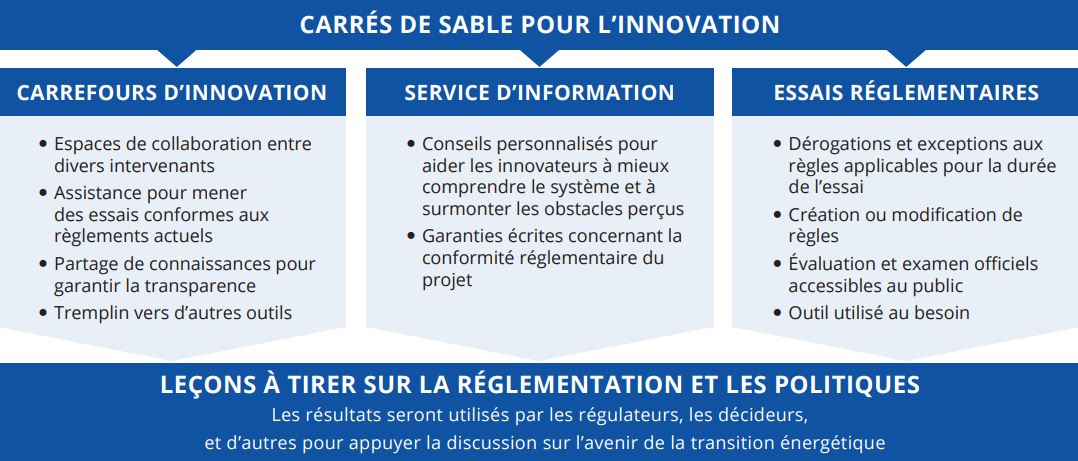Blog
Faire preuve d'innovation pour atteindre les objectifs du net zéro
In late December 2020, the federal government released a strengthened climate plan, significantly increasing its ambitions to reduce harmful emissions. Developing the clean-tech industry and deploying innovation are key components of its plan.
While Canada has a history of energy innovation – from nuclear to the oilsands – a new report produced by two Canadian non-governmental organizations, Pollution Probe and QUEST, shows that current policies and programs in the energy sector are falling short. Namely, they don’t support getting innovative with new business models and services that we will need to meet our net-zero targets.
We interviewed provincial and federal agencies, and utilities involved in energy innovation across Canada. What we found was that most current energy innovation programs focus on technological innovations, research initiatives and pilot projects. What they neglect is the importance of creating the conditions and capacity to get these innovations into the real world.
It can be difficult to get innovative technologies or business models into the energy sector. But the barriers are not due to a need for more advanced technology. In many cases, we have the technology. The barriers to their scale-up are elsewhere.
Regulators and policy-makers do not tend to focus on getting new and innovative services into the energy system. The complex regulatory system and cultural resistance to doing anything “new” also limit innovation. To overcome these non-technological barriers, energy innovation policies and programs should look to:
- Increase collaboration and knowledge sharing so that people can work together to reduce the barriers.
- Help innovators navigate the complex energy regulatory and policy landscape.
- Create space for safe real-world trials so they can demonstrate their market readiness.
- Use lessons from innovative initiatives and pilot projects to inform policy and regulatory changes, and remove the social and economic barriers to the diffusion of innovation.
Getting new and innovative services and business models into the energy system requires integrating and managing new technologies, while at the same time changing corporate cultures and envisioning new ways of running our energy programs.
Pollution Probe and QUEST are working together on a multi-year project looking at how “innovation sandboxes” can help get low-carbon innovation into the energy sector.
Innovation sandboxes are being used internationally to encourage innovation in many sectors, including energy. They create safe and controlled spaces for innovation to be integrated into the energy system by examining real (and often perceived) barriers, as well as testing solutions in a real-world environment. They allow for the development of new energy products, services and business models that can survive without public funding.
Innovation sandboxes use three tools – innovation hubs, enquiry services and regulatory trials – to effectively promote system-level innovation (figure 1). Innovation hubs use collaborative tools or platforms that allow the sharing of information and lessons among the diverse stakeholders in the energy sector. Enquiry services help innovators navigate the complex landscape and understand the barriers. Sometimes those barriers are not real, so this stage clears up any potential misconceptions. Finally, regulatory trials address real regulatory barriers by granting innovators temporary exemptions to test new ways of doing things. Findings and experience from the innovation sandboxes are then used to inform policy and regulatory changes.

Innovation sandboxes can be used to test new business models and regulatory structures in all areas, from electric-vehicle smart charging, smart homes, different transportation fuels such as hydrogen, and local markets for solar and storage, among others.
They can complement existing innovations and climate policies and programs to help Canada quickly and collaboratively transform its energy sector. While the strengthened federal climate plan talks about providing funding to accelerate the adoption of new and proven low-carbon technologies, we will need more than money to reduce the non-technological barriers that prevent them from being widely adopted.
The great news is that Canada is no stranger to innovation sandboxes. They already exist in the financial technology sector in Canada. Programs that have sandbox-like elements have been developed in several sectors within Canada, including energy, as well as at the federal, provincial, territorial and local government levels. The Ontario Energy Board – the energy regulator in Ontario – introduced the first energy innovation sandbox in 2019 following feedback about regulatory barriers and the desire to act quickly to encourage innovation. Elements of sandboxes have also been incorporated in some recent energy innovation.
It is time to introduce more innovation sandboxes in the energy sector. Preliminary results from Ontario’s initiative and international experience have shown that there can be great benefit to both innovators and consumers. The government has also recognized innovation as key to meeting climate-change targets.
But innovation often comes with uncertainty. There is no clear solution on how to integrate innovation and no clear understanding of how it will affect the entire system. There may be unintended outcomes that could jeopardize the system or harm consumers. By having innovation sandboxes enter Canada’s energy sector, we can control the risk of innovation and reduce uncertainty through creating new knowledge and enhancing collaboration among diverse stakeholders. For innovation sandboxes to aid in meeting Canada’s clean energy targets, all levels of government need to collaborate. Pollution Probe and QUEST will be working with different jurisdictions to help develop roadmaps for innovation sandboxes that meet their needs.
This article was originally published in Policy Options.
S'inscrire
Rejoindre la conversation!
Inscrivez-vous pour recevoir les dernières nouvelles et mises à jour sur les événements de QUEST Canada et recevez la newsletter mensuelle de QUEST Canada.


